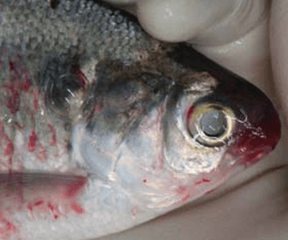Abergasilus
Abergasilus amplexus is a species of parasitic copepod endemic to euryhaline habitats in New Zealand. It is the only known species in the genus Abergasilus.
| Abergasilus | |
|---|---|
| Scientific classification | |
| Kingdom: | |
| Phylum: | |
| Subphylum: | |
| Class: | |
| Subclass: | |
| Order: | |
| Family: | |
| Genus: | Abergasilus Hewitt, 1978 |
| Species: | A. amplexus |
| Binomial name | |
| Abergasilus amplexus Hewitt, 1978 | |
Description
This species is unique among ergasilids in that it only has three pairs of legs: the fourth and fifth pairs are reduced to single spines or are completely absent.[1] The second antenna is very distinctive, hooks on the last and penultimate segments creating an obviously claw-like structure, more obvious in the female.[1] The male is free-living, forming part of the plankton.[2] Both sexes have an average length of 0.5 mm.[2]
Hosts
The main host appears to be Anguilla australis: in Lake Ellesmere, infestation rates on this eel approach 100%, sometimes with over 100 parasites on the gills of a single fish. Other recorded host species include Anguilla dieffenbachii, Arripis trutta, Carassius auratus, Galaxias maculatus, Perca fluviatilis, Pseudophycis bachus, Retropinna retropinna, Rhombosolea leporina, Rhombosolea plebeia and Rhombosolea retiaria.[1]
References
- G. C. Hewitt (1978). "Abergasilus amplexus gen. et sp. nov. (Ergasilidae; parasitic Copepoda) from fishes in Lake Ellesmere, New Zealand". New Zealand Journal of Marine and Freshwater Research. 12 (2): 173–177. doi:10.1080/00288330.1978.9515738.
- J. B. Jones (1981). "Abergasilus amplexus Hewitt, 1978 (Ergasilidae: Copepoda) from New Zealand, with a description of the male". New Zealand Journal of Marine and Freshwater Research. 15 (3): 275–278. doi:10.1080/00288330.1981.9515921.
| Wikispecies has information related to Abergasilus |
